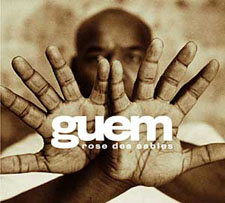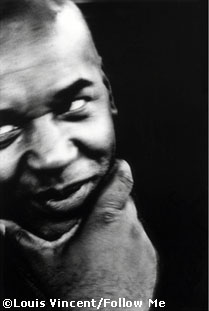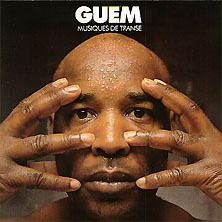Guem
Master of Percussion
Paris
23/05/2003 -
Master percussionist Guem is currently celebrating thirty years of career with his 30 th album. The djembe virtuoso marks the occasion with a special concert at the Zénith in Paris tomorrow where he is due to appear with Adama Dramé, Hugues Anoï and Les Tambours de Brazza. Music fans can expect a rhythm extravaganza !
 Guem's arrival at the Arts Centre in Paris is marked by creaking floorboards as he shifts his impressive bulk through the classroom to greet his pupils. The latter are already gathered in a circle, pounding out infectious beats on their djembes without waiting for the order "drum!" As he does every Monday, Guem slips silently into the circle of men and women of all ages and, with a simple glance and a touch on his drum, launches a new collective beat. Caressing his drumskin and coaxing the rhythm through his fingers, Guem pauses simply to ask his pupils whether their "hands are hot " and remind them to breathe as they play.
Guem's arrival at the Arts Centre in Paris is marked by creaking floorboards as he shifts his impressive bulk through the classroom to greet his pupils. The latter are already gathered in a circle, pounding out infectious beats on their djembes without waiting for the order "drum!" As he does every Monday, Guem slips silently into the circle of men and women of all ages and, with a simple glance and a touch on his drum, launches a new collective beat. Caressing his drumskin and coaxing the rhythm through his fingers, Guem pauses simply to ask his pupils whether their "hands are hot " and remind them to breathe as they play. Over the past three decades, despite a hectic recording and performing schedule, Guem has never abandoned his teaching – a fact which he explains modestly, saying "This is completely natural to me. It's like performing live in concert; a passion is something that should always be shared." Born to Nigerian parents living in the Algerian town of Batna, Guem grew up playing traditional music and trance rhythms from an early age. Performing at local baptism parties and weddings, the budding young percussionist was soon initiated into the secrets of the diwan (ceremonies where many of the participants enter a state of trance).
When he turned 16 Guem left his native Algeria for Paris, following his ambition to become a professional footballer with Red Star. But the young teenager soon came to realise that his hands would take him further than his feet. After a brief stint at the American Cultural Centre in Paris, Guem went on to make his name accompanying the crème de la crème of French and American jazzmen (including Michel Portal and Steve Lacy) and even tried his hand at mainstream 'variété' (performing with Colette Magny at "Le Chant du Monde" in 1972).
Guem also broadened his rhythmic repertoire playing with a wide range of musicians including West African artists based in Paris. But the "man with golden fingers" quickly grew bored of tours where managers stepped on stage to announce "eight musicians plus a percussionist!" Angered by percussion's lowly image, Guem set out on a one-man mission to raise percussion-playing's public profile and began organising a series of concerts where congas, bongos, djembes and darboukas were the major stars. Lifting percussion out of its traditional role as a backing instrument, Guem proved his drums could assure melody as well as rhythm.
In 1973 Guem went on to record his debut solo album, Percussions africaines. Five years later he would score his first major hit with Guem et Zaka (recorded in collaboration with his pupils from the American Cultural Centre). Around the same time Guem would also come up with his cult classic Le Serpent (which was re-recorded in 1996 for the French TV show Ça se discute). Meanwhile, Guem was still intent on broadening his musical horizons and, over the next few years, he would go on more than fifty trips to Africa, the Middle East and South America. After touring Brazil in 1982, Guem would stay on there to record another seminal album.
These days Guem's old LPs have become hot property on the electro scene with many of France's hippest DJs remixing his infectious rhythms. Turning the tables on his latest album, Roses des Sables (on which, incidentally, Guem plays all the instruments), the percussion master has invited three turntable wizards - Fred Galliano, Jeff Sharel and Oscar – to remix his rhythm "stories." RFI Musique hooks up with the djembe maestro in Paris before his show at Le Zénith:
 Where does your very physical style of percussion playing come from ? Mostly, I’d say, from my passion for the instrument and my love of the art itself. When I play percussion I feel like it’s really my body talking. When it comes down to it, the body is the first and primary instrument and the rhythm is life. When I’m at home I play a whole variety of string instruments (like violin, lute and guitar) and I get a lot of pleasure from them. But when I’m playing percussion it’s different, I really give my all! I come from a family where we’ve always played a lot of trance music, like Gnawa music from Morocco, candomble, macumba, voodoo and stuff like that. You’ve really got to put your all into it – like they say, skin attracts skin !
Where does your very physical style of percussion playing come from ? Mostly, I’d say, from my passion for the instrument and my love of the art itself. When I play percussion I feel like it’s really my body talking. When it comes down to it, the body is the first and primary instrument and the rhythm is life. When I’m at home I play a whole variety of string instruments (like violin, lute and guitar) and I get a lot of pleasure from them. But when I’m playing percussion it’s different, I really give my all! I come from a family where we’ve always played a lot of trance music, like Gnawa music from Morocco, candomble, macumba, voodoo and stuff like that. You’ve really got to put your all into it – like they say, skin attracts skin ! I never imagined for a moment that I would end up playing music as a profession. When I arrived in Europe I started playing a different kind of music, though. I played with a lot of different musicians and experimented with a whole variety of styles. People often say "blacks have rhythm." But they’re wrong – everyone’s got rhythm! The only thing is, you become arhythmic when you don’t accept other people’s rhythm.
Where do live shows fit into your life ?
My concerts are where I develop my style. In order to create my music in the first place I have to turn each piece into a story. I try and transform everything I’ve lived into music and percussion. As I don’t actually write music each piece has to have a story connected to it so I can remember them when I play. But when I play live on stage there’s the story, the actual composition and then everything you add to that.
Improvisation plays a major role in your live performances then ?
Yes, of course, there’s a basic theme and story to each piece, but I encourage the six musicians I work with to embroider around that... Once I’ve finished composing my music it’s physically out there on its own. It doesn’t belong to me any more; it belongs to everyone.
So each piece has a title linked to a particular story. There’s Combats de Coq (Cock fights) Cauchemars (Nightmares) and Nouba …
Yes, let me explain a bit. When I was writing Le Serpent (The Snake) I imagined I was walking deep in the forest somewhere. That’s why the track starts like that: "boom-boom-boom-boom" (Guem drums on the table, illustrating the rhythm). It was like those were my footsteps. Then suddenly this snake crosses my path – that’s like "tadadadada" - and then I get this burst of inspiration and I start recounting everything I see going on in the forest around me. That’s just my own personal interpretation of the piece. It’s up to individual listeners to make of it what they will. I can explain my music using stories, but I don’t actually want to sing. Everyone sings. But there’s something quite different about just keeping the voice of the percussion.
There’s a track you play called Transe…
It’s just a title I give to something. You can’t actually play trance on stage. In my opinion, a lot of people misuse the word trance, in the techno world, for instance. With this particular track what I was trying to show was that trance is intimately linked to percussion. It can take a whole night to enter a state of trance, you know. Some people manage to maintain it for a couple of hours, others can only hold it for five minutes before coming back to themselves again. But swallowing a pill to put yourself in a state of trance is a totally different thing altogether !
 Percussion is often associated with this idea of magic and the supernatural, though, isn’t it ?
Percussion is often associated with this idea of magic and the supernatural, though, isn’t it ? I’d say in a general way percussion can be a healing force. It’s not a question of witchcraft or anything. It’s simply a natural thing… I put part of myself into the music when I play, so there is a bit of a magic element to it – because I’m really giving something of myself, not just pretending. For a long time percussionists were really looked down on. They were the least respected of all musicians because they were seen as simple accompanists. Things have changed these days though. Whether they’re playing with ballets or orchestras, percussionists are respected and honoured now.
How have you seen the perception of percussion evolve in the West over the past 30 years ?
Percussion instruments have gained increasing respect. You know, the djembe's now the best-selling instrument in the world. Even people who can’t play own a djembe! But although the djembe is the best-selling instrument in the world that’s not to say it’s the most widely played. When you start out playing djembe it looks like an easy instrument to master. But when you start getting into it you realise that things are a bit more complicated than they first appeared. Your hands start hurting, you’ve got to memorise the rhythms and learn the technique… Having said that, anyone can learn to play the djembe these days. A wide variety of people turn up to my concerts and classes, young and old alike. Older people call me Guem, but the young ones call me Gouem, Brazilian style !
Over the past few years a lot of your records have ended up as re-mixes. Why did you decide to invite a selection of DJs onto your latest album ?
To see what would happen! A lot of DJs have already used my LPs in their mixes. But this time round it was different; I was the one giving them my recordings and inviting them to mix over the top. I gave them total "carte blanche" to do whatever they liked.
And are you happy with the result ?
Yes, I’m happy with it although I have to say I’d imagined something a bit different. I think they could have adapted themselves a bit more…When I play with other people I always try and adapt to their music, I try and embellish what they have there. In some of these mixes I feel the percussion gets left behind somewhere. For me, percussion is not just "boom boom boom" like techno. It’s something that can be melodic and very much alive !
Rose des Sables (Follow Me Productions/Nocturne)
Elodie Maillot
Translation : Julie Street










